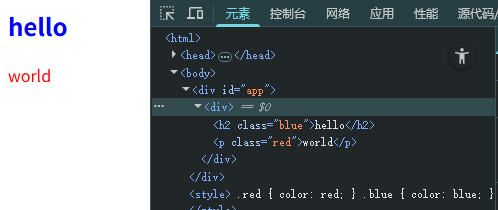实现h函数
练习
html
<style>
.red { color: red; }
.blue { color: blue; }
</style>
<div id="app"></div>
<script>
function h(tag, props, children) {
// TODO
}
function mount(vnode, container) {
// TODO
}
const vnode = h('div', null, [
h('h2', { class: 'blue' }, 'hello'),
h('p', { class: 'red' }, 'world')
])
mount(vnode, document.querySelector('#app'))
</script>
答案:
html
<!-- 已省略其他代码 -->
<script>
function h(tag, props, children) {
return {
tag,
props,
children
}
}
function mount(vnode, container) {
const { tag, props, children } = vnode
const el = document.createElement(tag)
if(props) {
for(const key in props) {
const value = props[key]
el.setAttribute(key, value)
}
}
if(children) {
if(typeof children === 'string') {
el.textContent = children
} else {
children.forEach(child => {
mount(child, el)
})
}
}
container.appendChild(el)
}
</script>有了h函数,我们就可以通过h函数来创建虚拟节点,然后通过mount函数将虚拟节点渲染到页面上。 接下来,对于虚拟节点的更新,我们需要实现patch函数。